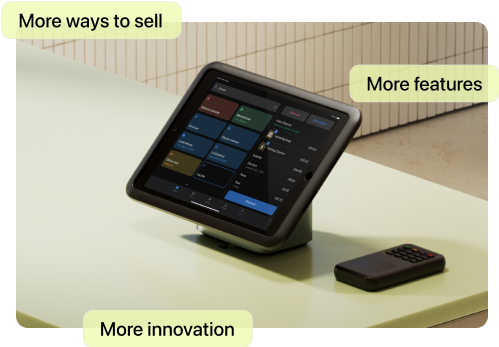An online boutique can be a profitable business venture for entrepreneurs interested in entering the fashion industry.
Digital innovation, technology, and changes in consumer spending have given independent online businesses the ability to compete against the big players. The best part? You already have the tools to create a beautiful online store and sell products at low cost. All you need is an internet connection.
This article will walk you through how to start an online boutique, with step-by-step instructions, insights, and firsthand experiences from online boutique owners.
Table of contents
What is an online boutique?
An online boutique is a specialized ecommerce store that caters to a specific audience. The term is often used to refer to independent clothing stores or lifestyle brands. It also suggests a business of a smaller size that sells luxury products or a hand-curated selection of products and brands within a niche.
Related article
How To Start a Clothing Business in 14 Steps (2025)

Building a clothing business takes equal amounts of strategy and creativity. Learn from a Project Runway alum how to identify customers and hone your style.
How to start an online boutique in 10 steps
- Choose a niche you’re passionate about
- Identify market gaps
- Write a business plan
- Develop your products
- Work on your brand
- Price your products
- Create your online store
- Invest in social selling and sales channels
- Create a shipping strategy
- Market your online boutique
The best online boutiques in the industry weren’t thrown together overnight. Even with a little trial and error, these owners had a business plan and process for getting started.
1. Choose a niche you’re passionate about
Some people don’t start an online boutique because they think they can’t come up with a great small business idea. Turns out, that’s not the obstacle you think it is.
Ask yourself: What’s your passion? You already have things you’re excited about in your everyday life, be it gardening, crafts, cycling, or skin care. By considering starting a business around something you’re passionate about, you’ll do everything possible to make your online boutique a reality.
Julie Clark, founder of Province Apothecary, said it best in an interview with Shopify. Enrolling in school for aromatherapy and treating clients in her classes solidified her decision to pursue skin care as a career. “I just fell in love with doing it all and just wanted that to be my life,” she says.

To find a niche market for your online boutique, ask yourself:
- What do you like to do in your spare time?
- What’s a common frustration you have that could be solved by a product?
- Are there any products you can sell related to your hobbies?
By narrowing down your passions and exploring those ideas, you’re already building your business. It also helps you do market research and decide how to position your online boutique for success. Yes, your business plan still matters, but knowing what you are (and are not) passionate about is critical for long-term success.
Pick a small but growing market and learn everything you can about it. Build expertise and share everything you learn. If you can create a body of content that connects with your audience, you’ll be well positioned to capitalize on it and grow your online boutique.
📚 Read more: How to Find Your Niche in 6 Steps
2. Identify market gaps
A successful online boutique won’t prosper on passion alone. Consider a problem in your niche market that isn’t currently being solved or a product that isn’t available. Is it a natural skin care cream that treats eczema? Or a line of handcrafted tableware from local artisans in your area? Figure out what products should exist that aren’t being offered by big and small competitors. Your business plan is going to play an important role in your future success.
Rhiannon Taylor, founder of RT1home, says that, when starting her home and gardening supplies boutique, she “quickly saw a need in the market for an indoor potting tarp. At the time, there were no high-quality products to prevent a mess when repotting plants.”

In her research, Rhiannon discovered a greater need for more high-end gardening supplies. “When I started RT1home, you couldn’t find nice supplies anywhere in the US, online or in-store. It was all cheap mass-produced stuff from Home Depot,” she says. “I started creating accessories like tarps and coverlets because they didn’t exist. I was making stuff I wanted to use for myself because I couldn’t find it.”
Rhiannon also saw a need for premium indoor gardening tools for urban gardeners. Most city dwellers don’t have the space for clunky gardening tools. To combat this, she began curating premium Japanese gardening tools and reselling them through her online boutique, which has proven to be a big hit with her target market.
3. Write a business plan
A business plan will guide your journey when creating an online boutique from home. It also validates your idea and helps you think through things efficiently. Take the time to solidify your strategy, spot potential obstacles, understand what resources you’ll need, and clarify your business idea before launch. A business plan will also help ensure your business finances are in order as you grow.
Ask yourself: What is the goal of my online boutique? Do I want to be a brand sold in retail outlets like Urban Outfitters? Do I want to be a high-end brand sold exclusively in my own ecommerce store?
If you want to start an online boutique, it’s critical to learn how to write a business plan.
4. Develop your products
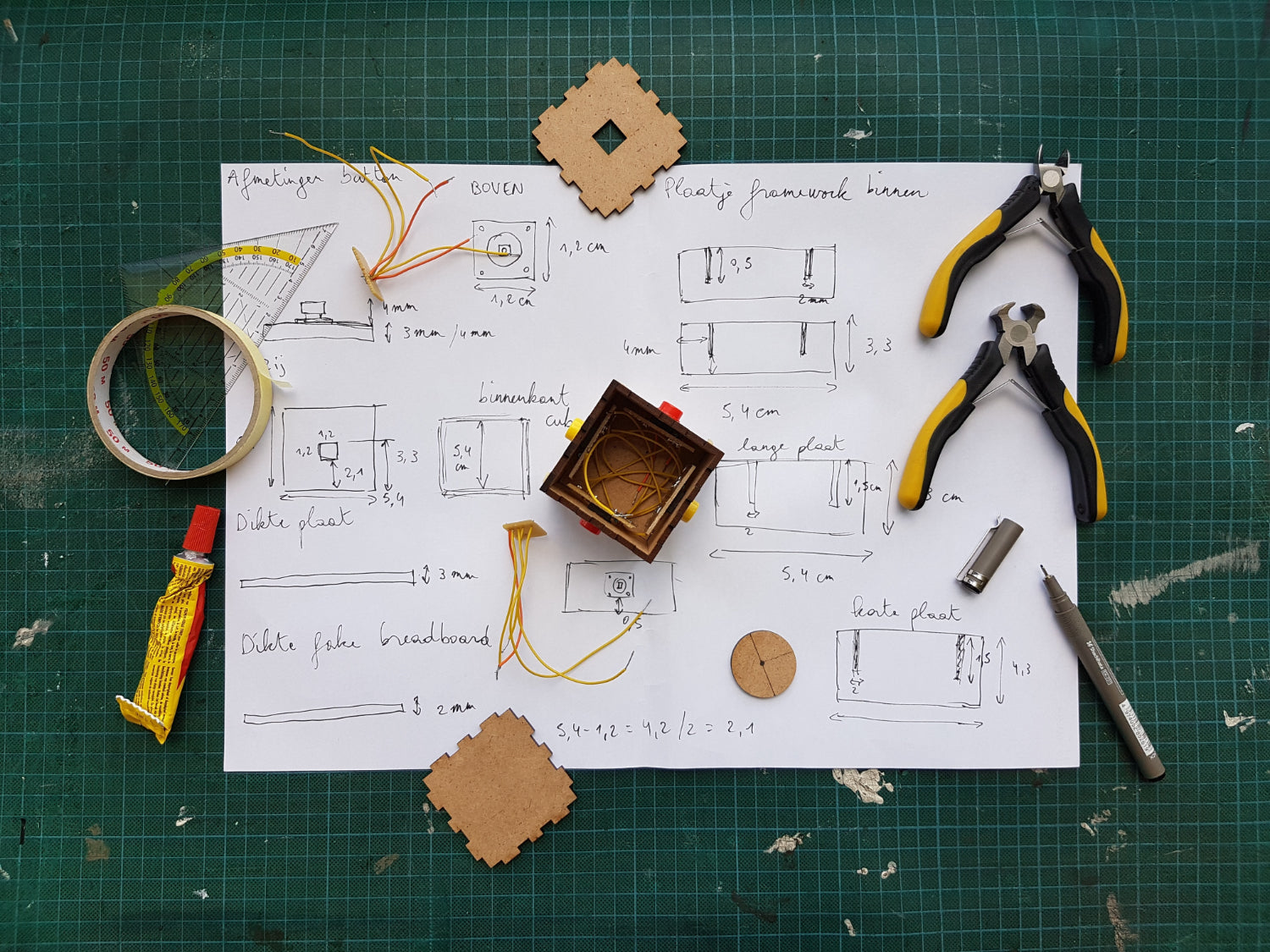
You have a lot of decisions to make when starting your online boutique. Beyond the products you want to sell, the biggest decision you’ll make is what business model to follow. Your business model helps determine what products you’ll offer and your future operational expenses.
Common models for developing products are:
- Dropshipping. With this model, a third party makes products and fulfills orders. You never hold inventory with a dropshipping model.
- Manufactured products. This involves an overseas (or domestic) company that manufactures your product and ships to your home or warehouse.
- Reselling. This model involves buying other brands’ products through a wholesaler and reselling them in your online store. This model is also ideal for vintage clothing brands.
- Handcrafted products. This method is related to creating products and fulfilling orders on your own. There are many things to make and sell for profit.
- Print on demand. This is similar to dropshipping, but with a print-on-demand model, you design the products (like t-shirts or pillows) and the third party makes it and fulfills the order.
Many of these models will involve an online boutique website. You can mix and match different models to meet your needs.
In Rhiannon’s case, local manufacturing was non-negotiable for her. “After a decade working with big corporations who heavily manufacture overseas, I have no interest in producing products like that,” she says.
Even as RT1home has seen record sales, it’s stayed true to its local production business model. Rhiannon continues to manufacture certain products in-house, while also working with sewists and local producers to turn mock-ups and sketches into reality.
If your boutique will rely on manufacturers, here are some tips for finding the best fit:
- Research online. Google, Yelp, and manufacturing directories are great places to find local producers.
- Reach out to a few candidates at once. Email or call direct to set up an appointment.
- Meet potential producers with professional mock-ups and prototypes. Communicate that you have a vision for your business. Don’t show up with rough sketches and random ideas.
When you’re first starting out, you have to prove yourself to producers. Most don’t do one-off projects. They won’t waste their time on your business if they don’t think you’ll be a long-term client. You need to show them you have a great vision and solid product ideas.
Sourcing suppliers and manufactures is a unique process, but it’s one of the costs of starting a business. It's not uncommon for small business owners to sometimes feel like they are hitting a brick wall, but with patience and perseverance, you’ll find the perfect partners for your online boutique.
📚 Read more:
- How to Find a Manufacturer or Wholesale Supplier for Your Product Idea
- The Benefits of a White Label Business (And 13 Product Ideas to Get You Started)
- Marketers Welcome: Start a Private Label Business With Already-Proven Products
- Alibaba Dropshipping: How to Safely Source and Manage Products from Alibaba
5. Work on your brand
While your business plan is critical, your branding is incredibly important. This means making a few decisions upfront:
- What does your brand stand for? What are your brand’s values?
- How would you like your brand identity to show up visually? What’s your aesthetic?
- How will you tell your brand story and what’s your brand voice?
- You’ll also need to choose a business name and design brand assets like a logo.
As an example of great branding, let’s look at the story behind Silk & Willow, an online textile boutique.
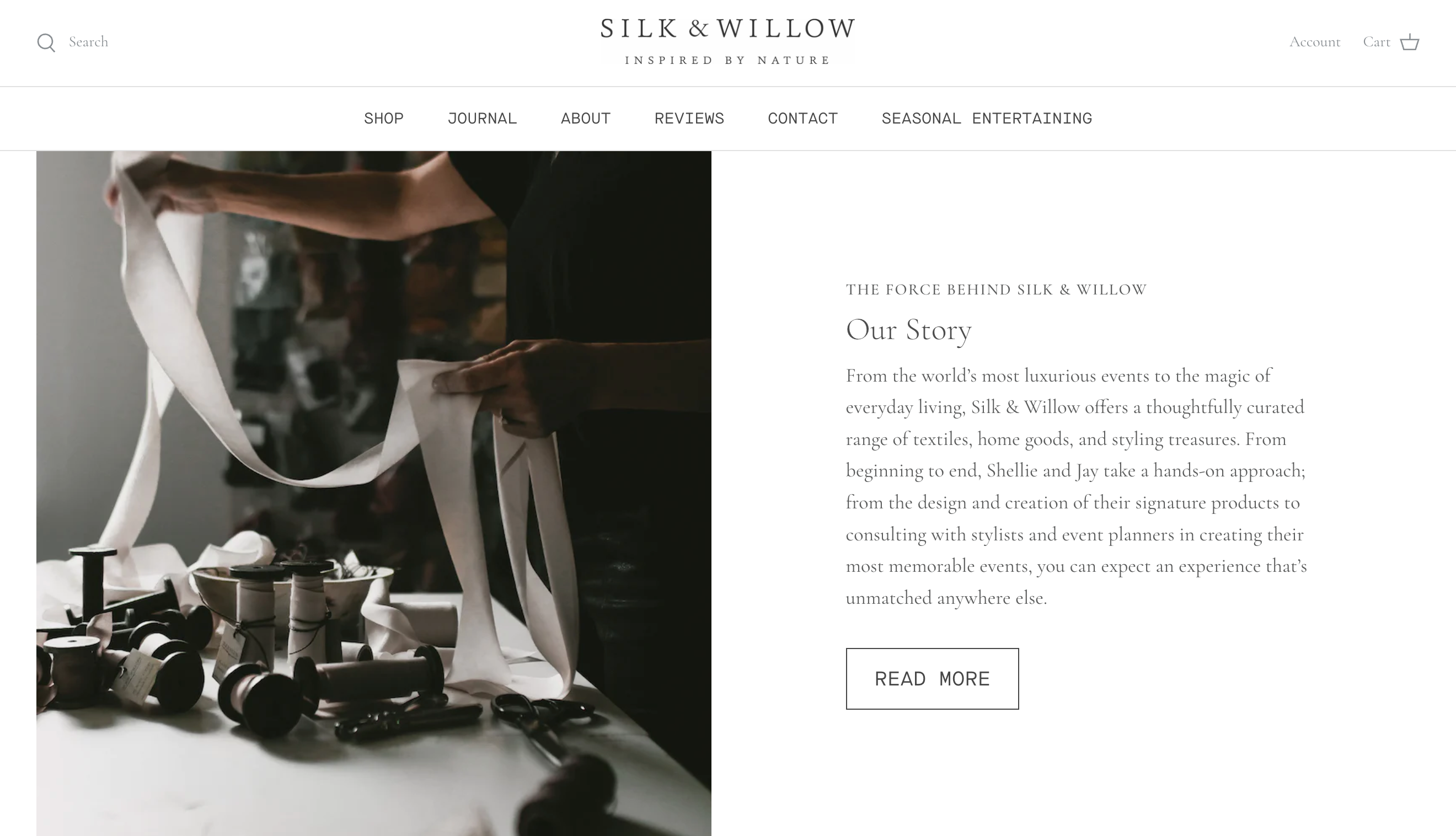
Silk & Willow’s story connects with its target audience through tone and relatability. Its business name embodies the feeling of the brand. It’s simple and memorable. Potential customers can easily find the brand online and help tell their story.
💡 Tip: Depending on your budget, you can hire an agency to find a brand name that’s fresh, relevant, and on trend. Or you can use Shopify’s business name generator and find non-trademarked business names for no cost.
6. Price your products
Choosing a price point for your products is one of the cornerstone decisions you’ll make. It affects every aspect of your business, including deciding on a target audience, cash flow and profit margins, sales tax, and understanding what expenses you can manage.
Figure out a pricing strategy that aligns with your market. Decide on a price that funds your production costs, but don’t dissuade the customers you’ll need to launch a successful online boutique.
📚 Read more: How To Price a Product in 3 Simple Steps
7. Create your online store
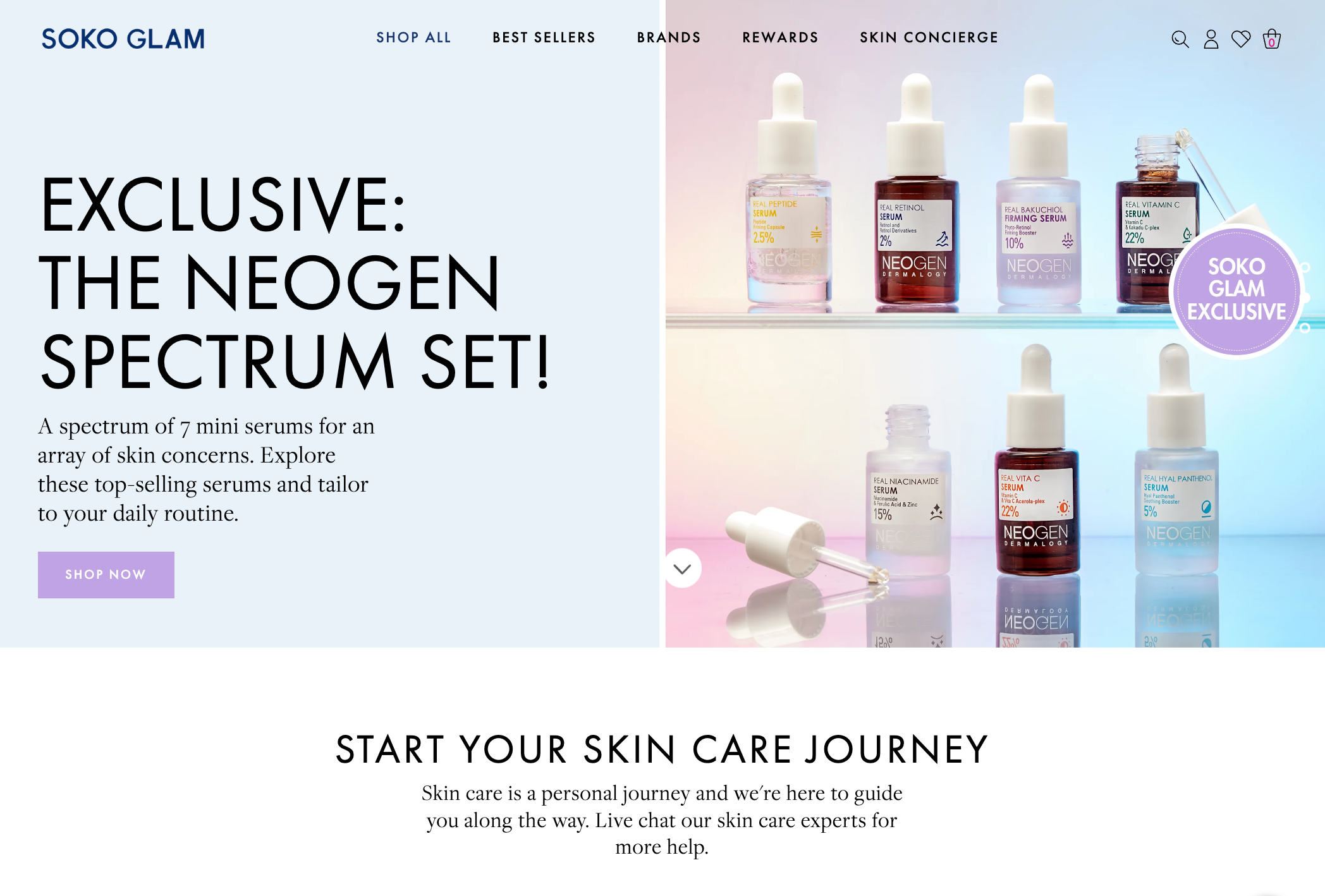
At this point, your new boutique needs a place to sell online. Shopify is a popular ecommerce platform for this, with millions of business building their online stores.
Starting an online store may seem like a daunting task compared to simply listing on online marketplaces, but it’s more profitable and rewarding when done right. You don’t pay high fees for making a sale or have to abide by any rules but your own.
“I built my first storefront on Squarespace, but as I started to grow, the website builder couldn’t adapt with me,” Rhiannon says. “I was constantly struggling to make changes to my store and integrate with other business tools.”
Rhiannon’s experience with Squarespace motivated her to find a new home on Shopify. “I chose a Shopify Theme, customized it to fit my brand, and migrated my products over in no time.”
📚 Read more:
- How To Choose the Best Domain Name (7 Tips & Tools)
- How to Start an Online Store with Shopify: A Step-by-Step Guide
8. Invest in social selling and sales channels
Rhiannon recommends building your online boutique first, then listing on online marketplaces like Etsy. She also recommends incorporating social media into your marketing strategy to build awareness. RT1home was a brand started on Instagram, and Shopify’s social media integrations were key to helping it sell more online.
In addition to an online store, Rhiannon recommends new boutique owners “not put all your eggs in one basket.” While she began on Instagram, it’s important to build a presence across multiple social media platforms, like Pinterest, Facebook, and TikTok.
9. Create a shipping strategy
So far, you’ve put a ton of effort into creating an incredible customer experience. You’ve done the research, developed your products, and built an online store for your boutique—all to keep customers happy.
But one thing that can ruin all your progress is a bad shipping experience. Shipping is a key part of your online boutique, from representing a major expense to how long an item takes to reach your customer. That’s why it’s so important to decide on a shipping strategy before you start marketing your new boutique. From the start, your business structure should account for shipping.
“Don’t sell yourself short on shipping. People want free shipping and shipping deals, but it’s expensive,” says Rhiannon. “I’ve seen a lot of new business owners lose money this way. Make sure you factor shipping into product costs if you go that route.”
Consider the following questions as part of your strategy:
- Where will you ship? Local, national, or international?
- What packaging will you use? Do you have fragile products with special packing needs? Are you interested in using sustainable solutions?
- Will you offer several modes of shipping? Consider rush shipping, local delivery, and curbside pickup.
💡 Tip: Use Shopify Shipping to curb shipping costs, get discounted rates, and speed up fulfillment.
10. Market your online boutique
The ultimate goal of marketing your online boutique is brand awareness.
You want to be known as the best seller for a product or niche. Your reputation is the unique intersection of your personality, skills, and experience that nobody else can compete with. Brands aren’t found, they’re created.
Once you’ve created your online store and have your business name, it's time to start marketing. From social media marketing to SEO, here are some options to consider.
Instagram marketing
This visual platform has become a go-to for online boutiques to show off products and find new customers. There are also many Instagram influencers happy to promote your brand in exchange for products. Instagram marketing includes both organic and paid marketing (ads and promoted posts).
Search engine marketing
SEO marketing helps people find you when they’re looking for particular products. Since they are high-intent buyers, you’ll get relevant traffic to your website that could lead to sales. You can achieve this organically or by paying for Google Ads.
Facebook ads
If you want to find a specific target audience for your products, Facebook ads can help you market to people who fit your profile. Don't have the budget to run ads consistently? Through Shopify Capital Marketing Funding, you can boost your ad budget and create buzz on Facebook.
Influencer marketing
Partner up with YouTubers, Instagrammers, bloggers, TikTokers, and other celebrities to get your products in front of the right audience. Influencer marketing can give credibility to your brand when real people promote products to audiences that match your target customer.
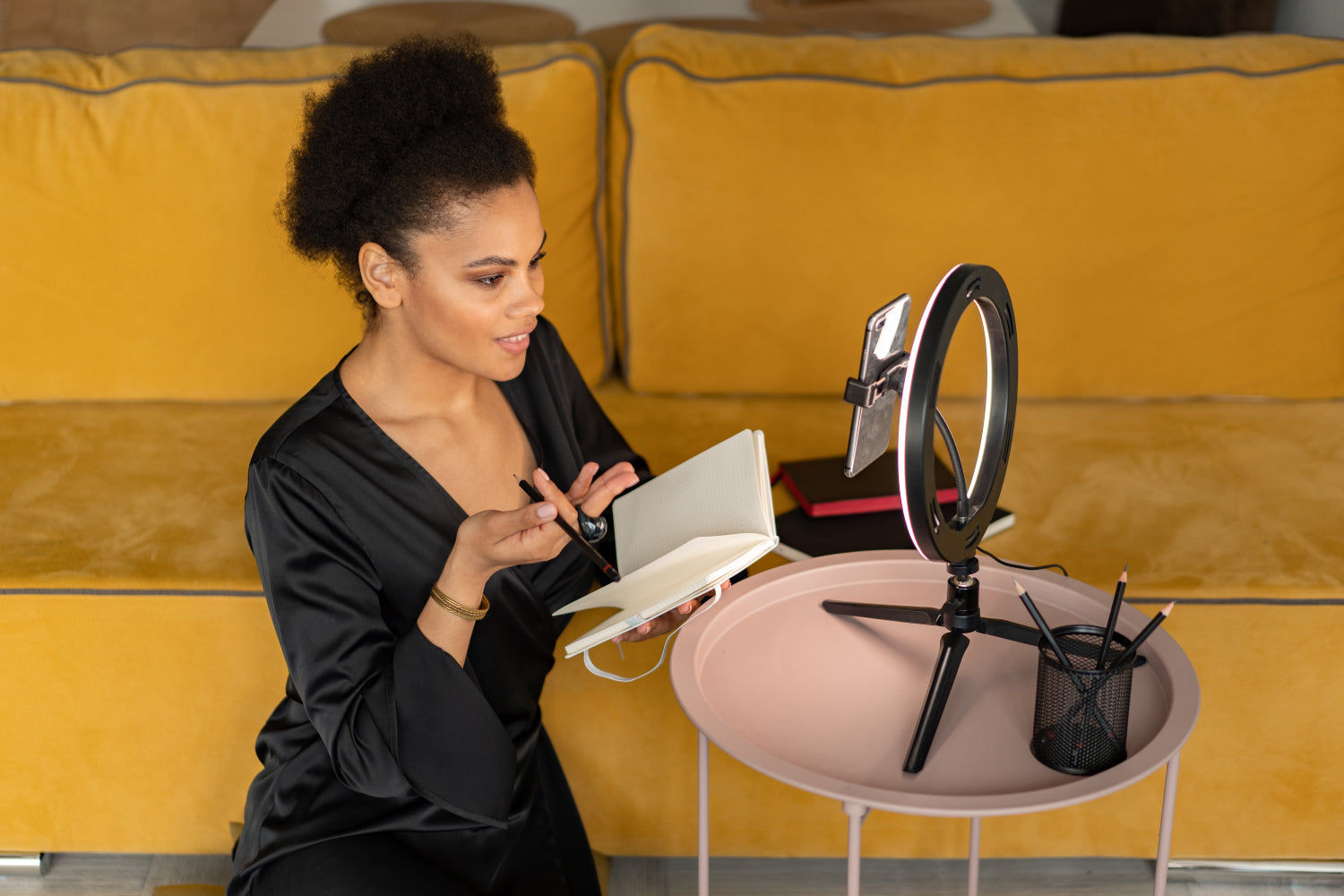
Public relations
Investing in public relations helps get conversations about your brand started with media outlets, customers, and retailers. In the case of Province Apothecary, Julie Clark says, “Someone would see us in a magazine or newspaper and reach out to us to carry us. It helped to expand the brand quickly.”
Email marketing
Email is one of the best “owned” marketing channels, where you control the content and distribution. You can build an email list and send messages to new and existing customers to sell, educate, or build loyalty with email marketing.
Content marketing
Rhiannon has found success with content marketing, writing blog articles and sharing tutorial videos on her ecommerce website. Evergreen content like blogs and videos, however, can drive leads and sales for years to come.
All these marketing ideas may seem overwhelming at first sight. But if you build your online boutique on Shopify, you can access more than 4,000 marketing and sales apps on the Shopify App Store. Most apps are plug and play, which means you just add them to your store and they start working right away. These apps are easy to use and help extend your store’s functionality to sell more online.
3 things to consider before starting an online boutique
There’s no sugarcoating it: Starting an online boutique can sometimes be stressful and challenging. Planning and following a strategic business plan is an important part of launching a small business, as it decides how your online boutique takes shape. The best online boutique owners aren’t just creatives, they are also driven entrepreneurs.
1. Starting an online boutique takes sweat equity
You won’t make your first sale overnight. But with dedication and by focusing your energy on the right tasks, you’ll approach your business with a sense of purpose and come out on top. As you’re wearing many hats (or all of them) in the early days of the business, take time to learn what you love about being an entrepreneur. Then, when you’re ready, delegate the rest.
2. Challenges come with the territory
You’ll be faced with challenges, especially if this is your first business. It’s important to stay motivated and manage expectations about your progress. Use challenges as learning moments as you create your online boutique. They’ll only help you build a better experience for your customers.
3. There may be legal requirements for you to do business
Consider legal aspects of your industry. Look into what business licenses and government regulations you need to operate. While there’s no specific license for owning a boutique, you may need a city, county, or state permit for taxes, purchasing inventory, and trademarking a brand name for your business.
5 best-in-class online boutique examples
Now that you know how to start an online store, let’s look at a few of the best examples of online boutiques for inspiration for your own online business.
1. The Narwhal Boutique

The Narwhal Boutique is a longstanding Toronto-based clothing boutique with a retail presence and an ecommerce business. The boutique specializes in niche, unique, and luxury independent brands with ready-to-wear pieces for women.
Why it works
With the retail boutique experience being the bread and butter of the business, The Narwhal Boutique’s online store takes a supporting role. The online boutique’s simple design lets bold product photography take center stage and a homepage carousel features the store’s latest collections.
2. Silk and Willow

Silk & Willow’s online boutique storefront is designed for showcasing its eco-friendly aesthetic and keen eye for wedding décor textures.
Why it works
You can browse through the brand’s collection of plant-dyed silk ribbons, table linens, and handmade stationary, getting lost in each captivating detail associated with planning a wedding. The brand uses beautiful imagery and detailed product descriptions to connect with an audience looking for a space that “feels luxurious, and makes your celebration timeless and unforgettable.”
3. Barking Babies

Vancouver-based company Barking Babies is a boutique, spa, kennel, pet store, and puppy-training facility all rolled into one. It offers just about every dog-related service you can think of, putting a huge emphasis on the social aspect of dog health.
Why it works
Much of the brand’s ecommerce website discusses the importance of dogs socializing with each other. It combines photos of clients’ dogs playing with each other, paired with haute products that you can’t find anywhere else. These give customers confidence that Barking Babies understands their needs.
4. Parks Canada Shop

The Parks Canada Shop is a merch store with a boutique feel. The official online store for Canada’s national parks sells products such as sweatshirts, mugs, and camping cutlery sets featuring Parks Canada branding and artist-designed goods. The shop caters to a niche audience of Canadian outdoor enthusiasts.
Why it works
The boutique’s extensive collection is easy to navigate, thanks to several sorting options in the upper nav bar. And, product pages contain helpful information including everything from sizing to product origin to customer reviews.
5. Province Apothecary

Province Apothecary was created to solve a common frustration Julie Clark had with medical skin care products. As someone who experienced a lifelong case of eczema, she was subjected to steroid cream after steroid cream, never finding a solution. She took matters into her own hands with Province Apothecary, developing certified vegan and ethically sourced skin care products, along with a physical location and skin care clinic.
Today, this natural remedies brand is a cult-favorite loved by Gwyneth Paltrow and Vogue.
Why it works
Province Apothecary’s website is full of helpful information to guide customers to make the right purchase decision. From guides to using the product to full ingredient listings, the online boutique demystifies the skin care shopping process.
Ready to launch a successful online boutique?
Now that you have the skills to launch an online business, it’s time to start building! Like every type of business, you want to focus on finding the right niche and getting your products in front of the right people. It’s normal to start an online boutique with no money as a side hustle, then grow it into a full-time at-home business.
In time, you’ll learn more about what products sell, the kinks in your operations, and who your best customers are. The important part is to start your new business today and make your own online boutique a reality.
Feature illustration by Cornelia Li
Read more
- How To Source Products To Sell Online
- How to Start a Dropshipping Business- A Complete Playbook for 2024
- How to Build a Business Website for Beginners
- The Ultimate Guide To Dropshipping (2024)
- What is Shopify and How Does it Work?
- The 13 Best Dropshipping Suppliers in 2024
- How to Make & Sell Lip Balm Online- Guide and Examples from Top Lip Care Brands
- How To Make and Sell Merch Your Fans Will Rave About
- Putting the Pieces Together- 26 CNC Projects That Sell
- 9 Part-Time Business Ideas to Start In Your Spare Time
How to start an online boutique FAQ
Is an online boutique profitable?
Selling clothing, lifestyle goods, and other niche products is a profitable way to make money online. It is estimated that the apparel and accessories online retail sector will reach about $159 billion in the US alone by 2025. Profitability in any industry, however, relies on finding the right product for the right audience at the right time. Your business plan should include a detailed financial plan that will help you forecast profitability.
What are the best online boutiques?
The best online boutiques are those that understand their target audience, provide stellar customer service, and offer a unique and personalized online shopping experience. A best-in-class online boutique has an ecommerce website that’s responsive and easy to navigate. It brings the best of the in-store experience online. Some examples include Lisa Says Gah, House of Sunny, and Soko Glam.
How do I start an online clothing boutique?
To start an online clothing boutique, follow these steps:
- Choose a niche.
- Identify market gaps.
- Write a business plan.
- Develop your products.
- Choose a brand name and logo.
- Price your products.
- Create an online store.
- Figure out shipping.
- Market your online clothing boutique.
Do I need a business license to start an online boutique?
Depending on your country or region, you may need a business license or meet other legal requirements. Depending on your business structure, you may need a seller’s permit (or seller’s license) to sell your products online. Most states in the US require a seller’s permit to legally sell online, but requirements and fees vary by state. These will be important documents for paying sales tax.




